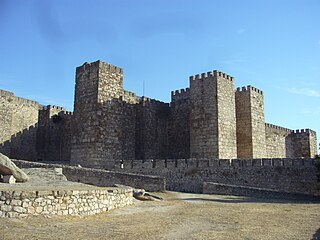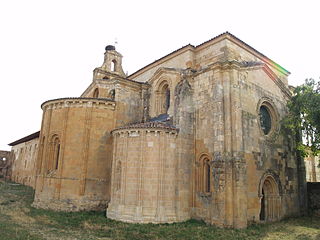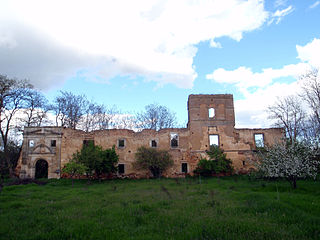The Mutiny of the Trout (Spanish: Motín de la Trucha) was a semi-legendary popular revolt in Zamora, Spain, in late 1157. The uprising is first mentioned in a late 15th-century manuscript. While the story is not inherently implausible, there is no near-contemporary evidence for it and modern scholars have been hesitant to accept it as historical.

Zamora is a city in Castile and León, Spain, the capital of the province of Zamora. It lies on a rocky hill in the northwest, near the frontier with Portugal and crossed by the Duero river, which is some 50 kilometres (31 mi) downstream as it reaches the Portuguese border. With its 24 characteristic Romanesque style churches of the 12th and 13th centuries it has been called a "museum of Romanesque art". Zamora is the city with the most Romanesque churches in all of Europe. The most important celebration in Zamora is the Holy Week.
The revolt supposedly began as a dispute over a trout. The steward of Gómez Álvarez de Vizcaya, the town governor or regidor, tried to requisition an especially fine-looking trout from a local fishmonger who had already promised to sell it to the shoemaker. The steward then claimed that the regidor had prior rights. During the ensuing argument, which attracted several other townsmen to support the shoemaker, the steward arrested the latter and some of his supporters. This sparked a riot. Some local knights, including the eldest son (unnamed in the sources) of Count Ponce Giraldo de Cabrera, then governor of Zamora, convened in the church of Santa María to discuss the proper course of action, the rioters locked them in and set the church alight, burning to death all inside. They then razed to the ground the house of the regidor, and, fearing the reprisals of Count Ponce, they fled en masse to the Portuguese border and asked the king, Ferdinand II, through messengers to pardon them and confiscate Ponce's lands ( tenencias ). Ferdinand feared that they would abandon Zamora permanently and settle in Portugal, the kingdom of his enemy. The enemies of Ponce de Cabrera at court counselled the king to accede to the townsfolk's demands, and so pardon was granted and Ponce was deprived of his governorships and exiled.

Trout is the common name for a number of species of freshwater fish belonging to the genera Oncorhynchus, Salmo and Salvelinus, all of the subfamily Salmoninae of the family Salmonidae. The word trout is also used as part of the name of some non-salmonid fish such as Cynoscion nebulosus, the spotted seatrout or speckled trout.
Ponce Giraldo de Cabrera, called Ponç Guerau in Catalan or Pons in Occitan, was a Catalan nobleman, courtier and military leader in the kingdoms of León and Castile.

The Kingdom of Portugal was a monarchy on the Iberian Peninsula and the predecessor of modern Portugal. It was in existence from 1139 until 1910. After 1415, it was also known as the Kingdom of Portugal and the Algarves, and between 1815 and 1822, it was known as the United Kingdom of Portugal, Brazil and the Algarves. The name is also often applied to the Portuguese Empire, the realm's extensive overseas colonies.
One commentator has seen in the story "notable indications of its veracity" (no desdeñables indicios de su veracidad), but it is not widely accepted by historians. Urban uprisings were characteristic of the Kingdom of León at the time. In 1161 there was one in Lugo and in 1162 a further two in Salamanca and Ávila. The exile of Ponce de Cabrera is also a historical fact, but no source other than the Mutiny story provides a reason for it. He soon returned to favour:
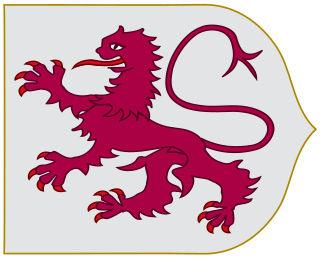
The Kingdom of León was an independent kingdom situated in the northwest region of the Iberian Peninsula. It was founded in AD 910 when the Christian princes of Asturias along the northern coast of the peninsula shifted their capital from Oviedo to the city of León. The County of Castile separated in 931, the County of Portugal separated to become the independent Kingdom of Portugal in 1139 and the eastern, inland part of León was joined to the Kingdom of Castile in 1230.

Lugo, also called Lucus Augusti in Latin, is a city in northwestern Spain in the autonomous community of Galicia. It is the capital of the province of Lugo. The municipality had a population of 98,025 in 2018, making it the fourth most populous city in Galicia.
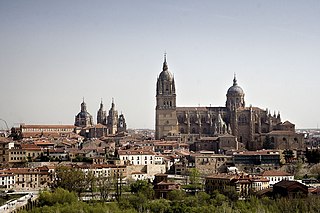
Salamanca is a city in western Spain that is the capital of the Province of Salamanca in the community of Castile and León. The city lies on several hills by the Tormes River. Its Old City was declared a UNESCO World Heritage Site in 1988. With a metropolitan population of 228,881 in 2012 according to the National Institute of Statistics (INE), Salamanca is the second most populated urban area in Castile and León, after Valladolid (414,000), and ahead of León (187,000) and Burgos (176,000).
|
|








